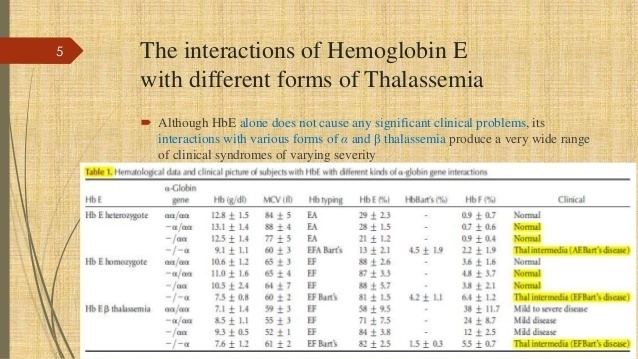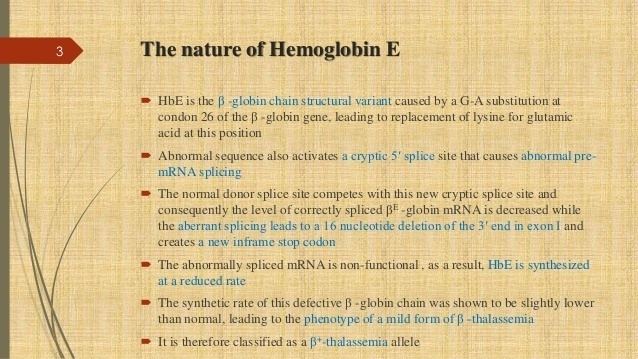ICD-10 D58.2 MeSH D006446 | DiseasesDB 29719 | |
 | ||
Hemoglobin E or haemoglobin E (HbE) is an abnormal hemoglobin with a single point mutation in the β chain. At position 26 there is a change in the amino acid, from glutamic acid to lysine. Hemoglobin E has been one of the less well known variants of normal hemoglobin. It is very common in Southeast Asia but has a low frequency amongst other ethnicities. HbE can be detected on electrophoresis.
Contents
- What is the definition of hemoglobin e medical dictionary free online terms
- Hemoglobin E disease EE
- Hemoglobin E trait heterozygotes for HbE AE
- Heterozygotes for HbE SE
- Hemoglobin E thalassaemia
- Epidemiology
- References

The βE mutation affects β-gene expression creating an alternate splicing site in the mRNA at codons 25-27 of the β-globin gene. Through this mechanism, there is a mild deficiency in normal β mRNA and production of small amounts of anomalous β mRNA. The reduced synthesis of β chain may cause β-thalassemia. Also, this hemoglobin variant has a weak union between α- and β-globin, causing instability when there is a high amount of oxidant.

What is the definition of hemoglobin e medical dictionary free online terms
Hemoglobin E disease (EE)
Hemoglobin E disease results when the offspring inherits the gene for HbE from both parents. At birth, babies homozygous for the hemoglobin E allele do not present symptoms due to HbF (fetal hemoglobin) they still have. In the first months of life, fetal hemoglobin disappears and the amount of hemoglobin E increases, so the subjects start to have a mild β-thalassemia. People who are heterozygote for hemoglobin E (one normal allele and one abnormal allele) do not show any symptoms (there is usually no anemia or hemolysis). There are cases associated with haemolysis. Subjects homozygous for the hemoglobin E allele (two abnormal alleles) have a mild hemolytic anemia and mild enlargement of the spleen.
Hemoglobin E trait: heterozygotes for HbE (AE)

Heterozygous AE occurs when the gene for hemoglobin E is inherited from one parent and the gene for hemoglobin A from the other. This is called hemoglobin E trait, and it is not a disease. People who have hemoglobin E trait (heterozygous) are asymptomatic and their state does not usually result in health problems. They may have a low mean corpuscular volume (MCV) and very abnormal red blood cells (target cells). Its clinical relevance is exclusively due to the potential for transmitting E or β-thalassemia.
Heterozygotes for HbE (SE)

Compound heterozygotes with hemoglobin sickle E disease result when the gene of hemoglobin E is inherited from one parent and the gene for hemoglobin S from the other. As the amount of fetal hemoglobin decreases and hemoglobin S increases, a mild hemolytic anemia appears in the early stage of development.
Hemoglobin E/β-thalassaemia
People who have hemoglobin E/β-thalassemia have inherited one gene for hemoglobin E from one parent and one gene for β-thalassemia from the other parent. Hemoglobin E/β-thalassemia is a severe disease, and it still has no universal cure. It affects more than a million people in the world. The consequences of hemoglobin E/β-thalassemia when it is not treated can be heart failure, enlargement of the liver, problems in the bones, etc.
There is a variety of genotypes depending on the interaction of HbE and α-thalassemia. The presence of the α-thalassemia reduces the amount of HbE usually found in HbE heterozygotes. In other cases, in combination with certain thalassemia mutations, it provides an increased resistance to malaria (P. falciparum).
Epidemiology
Hemoglobin E is most prevalent in Southeast Asia (Thailand, Myanmar, Cambodia, Laos, Vietnam), where its prevalence can reach 30 or 40%, and North-East India, where in certain areas carrier rates reach 60% of the population. In Thailand the mutation can reach 50 or 70%, and it is higher in the North-East of the country. It is also found in China, the Philippines, Turkey, Nepal, Sri Lanka, Pakistan, etc. The mutation is estimated to have arisen within the last 5,000 years. In Europe there have been found cases of families with hemoglobin E, but in these cases, the mutation differs from the one found in South-East Asia. This means that there may be different origins of the βE mutation.
